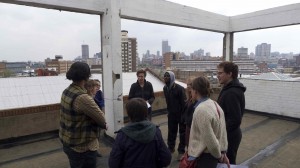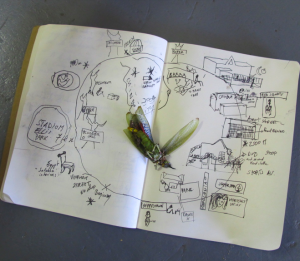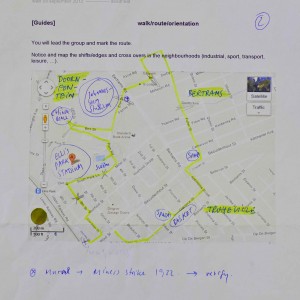Marche avec / Walk with Dorothée
Auteurs / Authors : Dorothée Kreutzfeld, Irène Tchernooutsan, François Duconseille, Adrien Maufay, Pauline Lepeu, Juliette Autin
Description : On saturday 8th Dorothée Kreutzfeld proposed to a part of the group a walk across the neighbourghood of the King Kong building. She attributed to each participant a “mission” to collect several informations about the context…
Axes de recherche / Research axes (Play/Urban) : public space / people as infrastructure
>>>>>>>>>>>>>>>>>>>>>>>>>>>
In situ (may include different times > time 1, time 2, time 3, etc..)/ peut inclure différentes étapes > Temps 1, Temps 2,Temps 3, etc..
Medium :
Genre : Marche, collecte
Concept : Découvrir la ville en s’attardant sur un type de détails
Participants : Dorothée, Irène, François Adrien, Pauline, Juliette,
Durée / Duration : une après midi
Ville / City : Joburg
Questions :
>>>>>>>>>>>>>>>>>>>>>>>>>>>
Analyse critique / Critical analysis :
>>>>>>>>>>>>>>>>>>>>>>>>>>>
Protocoles (collectif) d’action / (collective) Action protocols : Chacun à une mission: prendre les sons, noter tous les commerces….

[Guides] > walk/route/orientation
You will lead the group and mark the route.
Notice and map the shifts/edges and cross overs in the neighbourhoods (industrial, sport, transport, leisure, …).
[Guards] > territory/ ownership/ codes
you are in charge of ‘security’ of the walk
- walk at the head of the group
- walk at the end of the group
- notice formal and informal guards (security guards of property, car guards, shop security, etc.)
- uniforms
- stance
- field/area they patrol (public/private)
- how they patrol/guard
- numbers
- dogs
- signs of security (beware of dogs ; entry at own risk etc.)
- notice if you can oversee the ‘territories’ of the walk (open public square, enclosed mall, entrances,
- vacant plots, gardens, walls, streets etc.
collection of security’s items (see PDF)
[shops] > trade/transaction
map the types of shops you will pass
- indicate what buildings the shops are in
- map the traders you will pass (street traders…)
- map any other type of transaction/sale you may notice on the walk
- notice if the types of shops shift from neighbourhood to neighbourhood
- notice if you can guess the nationality of the shop owner
- enter shops if you wish China Mall : Decide for the group if you should enter the mall or not and what you should purchase (umbrella, shoes, nail polish etc.)
some announcements and commerces (see PDF)
[ Sounds]
Map the sounds you hear along the route/walk –
- Industrial, traffic, churches, birds, wind, objects, conversations in shops, music…
- Allocate the source of the sound ;
- Note the impact of the sound – familiar, disorientating, activity, sense of neighbourhood, accident…
- Be silent if need be.
[Field] > Planning/Surplus Ground/drawing
You will pass a public square in the sports precinct, vacant lots, a basket ball court – they form part of urban development, planning and the history of the neeighbourhoods.
- Note how they are used and by whom.
- Note what ‘marks’ these sites (public sculpture, walls of adjacent properties, dumps, signs)
- Choose two of the sites ; ask the group to draw for ten minutes ; decide what you want the group to draw ;
- Imagine what has been here before.
- Choose one of the sites ; ask the group to move in across it or come up with a formation (line, walk etc.) that responds to the spatial character of the site.
- Locate these fields along the walk – how are they linked by streets or structures, signage or landmarks.
[people] > infrastructure/neighbourhood/stranger/resident
You will pass people along the route which takes you through different neighbourhoods.
- The neighbourhoods of Bertrams and Troyeville are known for their mixed residential fabric (Portuguese South Africans, immigrants form Ethiopia, Mozambique, DRC, Somalis, Nigeria,South African low and middle class families, etc.).
- See if you can recognise these classifications.
- Note how people walk ; where you find more people ; how people gather ;
- Note what people do (garden, shop, talk, hang out, play, wash, drive)
- Note interactions between the group and people in the neighbourhood, shops, streets, etc.
- Note how people greet each other.
- Note different dress codes.
- Note the languages you hear.
- Greet.
[Churches] > Grace/ neighbourhood/ ritual
You will pass many churches on the route.
- Write down the names.
- Map the denomination of the church and the times of services.
- Note in what buildings the churches are set up. What do you think the buildings were used for ?
- Enter two churches if you can – observe the interior/atmosphere/dress/icons..
- Notice anything that speaks of faith and religion.
[Green] > urban/sub-urban/underground/source
Doornfontein = doringbome (thorn) ; fountein (spring)
You will walk in a valley ; you will be close to the source of the Jukskei River which runs into Bez valley, then north through Alexandra, Hartebeesport Dam, into Crodile River and the Indian Ocean. You will walk on one side of the watershed. You will walk above storm water drains. You will walk in an area that used to be a farm. You will pass old Oak trees and newly trees.
- Notice and map where the ‘natural’ landscape intersects with the urban landscape ;
- Notice the rigdes to the north and the south ;
- Notice grass patches, shrubs, lawns, gardens ; distinguish types of treess (are they maintained), flowers ;
- Distinguish between maintained greens and ‘wild’ greens.
- Notice any animals that you see (birds, dogs, chicken, rats…)
[Games] > chance/planned/neighbourhood
You will pass a sport precinct, where rugby, soccer, boxing, tennis, athletics, swimming, etc. take place.
- This is where some of the World Cup Games were played.
- The precinct also often houses concerts and church gatherings.
- You will also pass Schools with playrgounds and a basket ball court. Map all of these – indicate the differences (branding, scale, maintenance, impulsive…)
- Map the types of games you may come across – as indicated in the architecture and in the use/activities (kids playing, betting, card games, slot machine, hair dressers, bars/pool tables etc.)
- Map potential uses of the spaces/architecture that could become games (BRT route, vacant lots, trees, streets for racing etc.)
- Notice anything that is ‘performative’ (the way people walk, the way kids play, the way buildings have been altered etc. .
- Notice anything that you would consider an event – an accident, a confrontation or joke.
- If you find a bar with a pool table, enter and play a game.
collection of games and playgrounds (see PDF)


